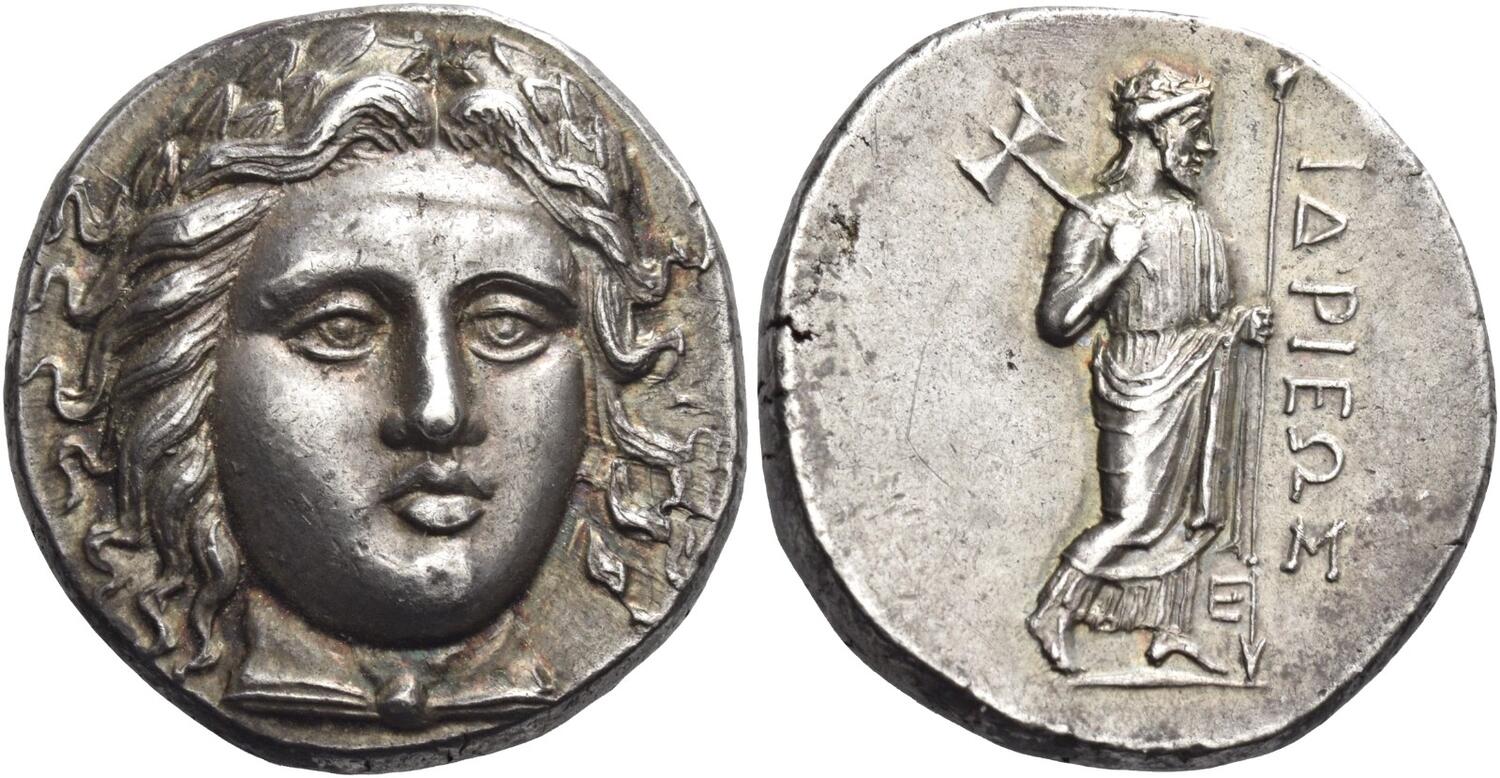Halicarnassus (Idrieus), silver, tetradrachms (351-343 BCE)
From SILVER
351 BCE - 343 BCE Silver 7,089 kg
Description
| ObverseInscription or printing placed on the obverse.: | Laureate head of Apollo facing three-quarters right. |
| ReverseInscription or printing placed on the reverse.: | IΔPIEΩΣ (Greek).Zeus Labraundus standing right, holding double axe and spear, in lower middle field, E. |
Mint and issuing power
| MintIdentifies the place of manufacture or issue of a numismatic object.: | Halicarnassus | Ancient regionAncient region.: | Caria | Modern countryModern country: Turkey | AuthorityIdentifies the issuing power. The authority can be "pretended" when the name or the portrait of X is on the coin but he/she was not the issuing power. It can also be "uncertain" when there is no mention of X on the coin but he/she was the issuing power according to the historical sources: | Idrieus (satrap of Caria, mid-4th century BC), Persian Empire |
Chronology
| FromIdentifies the initial date in a range assigned in a numismatic context. | 351 BCE | toIdentifies the final date in a range assigned in a numismatic context.. | 343 BCE | PeriodTime period of the numismatic object.: Classical 480-323 BC |
Physical description
| MetalThe physical material (usually metal) from which an object is made.: | Silver |
Median weightMedian of the weights of numismatic objects (in grams). in grams | 15.20 | DenominationTerm indicating the value of a numismatic object. Examples: tetradrachm, chalkous, denarius.: | tetradrachm |
StandardStandard.: |
Image

AC249 Halicarnassus.jpeg [1]
References
| Die study referencePublication of the study: | Konuk 1998b1Konuk 1998b, n° 1-97 (D1-D23 et R1-R58). | ||
| Coin series referenceReference to coin series study: | Sear II2Sear II, n° 4958, RQEMAC3RQEMAC, n° 249 | ||
| Coin series web referenceCoin series web references: | |||
Obverse dies distribution
| FrequencyFrequency of specimen in distribution. ᵖ | Number of obversesNumber of obverse dies. ᵖ (o) | % (o) | Number of coinsNumber of coins. (n) | % (n) | Die nameName(s) of the die(s). |
| 1 | 3 | 13.04 | 3 | 1.28 | 3, 4, 16 |
| 2 | 4 | 17.39 | 8 | 3.42 | 5, 8, 9, 10 |
| 3 | 2 | 8.7 | 6 | 2.56 | 2., 23 |
| 4 | 1 | 4.35 | 4 | 1.71 | 2 |
| 5 | 1 | 4.35 | 5 | 2.14 | 1 |
| 6 | 1 | 4.35 | 6 | 2.56 | 22 |
| 7 | 1 | 4.35 | 7 | 2.99 | 21 |
| 8 | 1 | 4.35 | 8 | 3.42 | 18 |
| 9 | 2 | 8.7 | 18 | 7.69 | 18 |
| 11 | 1 | 4.35 | 11 | 4.7 | 11 |
| 13 | 1 | 4.35 | 13 | 5.56 | 7 |
| 22 | 2 | 8.7 | 44 | 18.8 | 12, 14 |
| 26 | 1 | 4.35 | 26 | 11.11 | 6 |
| 34 | 1 | 4.35 | 34 | 14.53 | 13 |
| 41 | 1 | 4.35 | 41 | 17.52 | 17 |
| Total | 23 of 23 | 100.03 | 234 of 234 | 99.99 |
Reverse dies distribution
no distribution is available
Quantification
| Number of obversesNumber of obverse dies. ᵖ (o) | 23 | Number of singletons (o1)The number of singleton coins. ᵖ | 3 |
| Number of reverse diesNumber of reverse dies. (r) | 58 | Number of coinsNumber of coins. (n) | 234 |
| Coins per obverse dieNumber of coins per obverse die. (n/o) | 10.17 | Coins per reverse dieNumber of coins per reverse die. (n/r) | 4.03 |
| Reverse per obverse ratioRatio of obverse dies divided by reverse dies. (r/o) | 2.52 | Percentage of singletons (o1)number of coins (n) divided by the number of singletons (o1) ᵖ | 13.04 % |
| Original number of dies (O) (Carter 1983 formula)The estimation of the number of coins according to Carter 1983 ᵖ | 23.32 | Coins struck if 20,000 as average productivity per dieCoins made if the average productivity for obverses (according to Carter) is 20,000. ᵖ | 466,400 |
| Original number of dies (O) (Esty 2011 formula)The estimation of the number of coins according to the singleton formula in Esty 2011 ᵖ (O) | 25.51 | Survival rate if 20,000 as average productivity per dieSurvival rate if average productivity is 20,000. ᵖ | 0.00050 |
| Coverage (o = % of O) (Esty 1984 formula)Esty 1984 - coverage (% of O) ᵖ (o = % of O) | 98.72% | Die productivity if survival rate 1/2,000Average productivity if survival rate is 1/2,000. ᵖ | 20,068.61 |
| Weight of silver (in kg) if 20,000 coins per die (O = Carter formula)Carter 1983 * Median weight * 20000 (*10 if gold or electrum) ᵖ | 7,089 kg <br /> 7,089 kg | Die productivity if survival rate 1/5,000Average productivity if survival rate is 1/5,000. ᵖ | 50,171.53 |
Remarks
Likely military